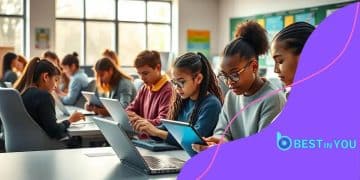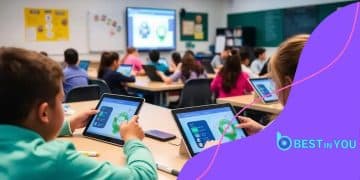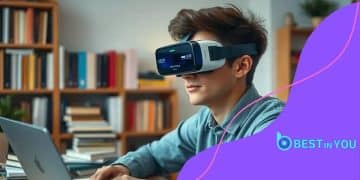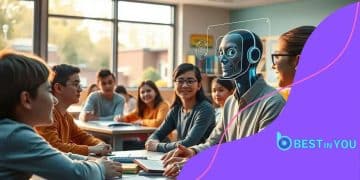The future of virtual reality classrooms in STEM education
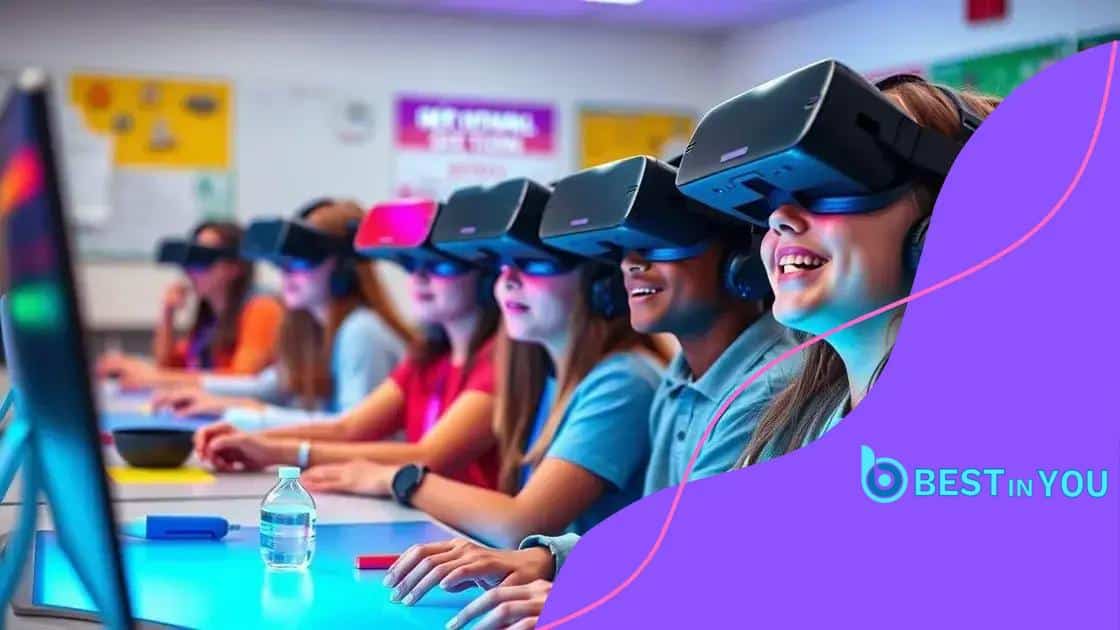
The future of virtual reality classrooms in STEM education enhances learning through immersive experiences, personalized paths, and collaborative engagement, enabling students to understand complex concepts effectively.
The future of virtual reality classrooms in STEM education is shaping how students engage with complex concepts. Imagine students exploring the depths of the ocean or traveling through space—all from their classrooms. This article delves into how VR is transforming the educational landscape.
Benefits of virtual reality in STEM education
The benefits of virtual reality in STEM education are vast and transformative. By integrating VR into the classroom, students can experience science, technology, engineering, and math in ways that were previously unimaginable. This technology motivates learners, engages their interests, and enhances understanding.
Immersive Learning Experiences
One of the main advantages of VR is its ability to provide immersive learning environments. Students can explore complex concepts visually, making learning more interactive.
- Students can conduct virtual experiments without safety concerns.
- They can visualize abstract ideas, like molecular structures, in 3D.
- Learning happens in a safe, controlled environment.
This hands-on approach allows for deeper engagement. Imagine a biology student observing the human anatomy from within—it’s both fascinating and educational. Such experiences can lead to improved retention of information.
Enhanced Collaboration
Virtual reality also promotes collaboration among students. They can work together in a shared space, regardless of their physical location. This collaborative aspect encourages teamwork and problem-solving skills.
- Students can tackle engineering challenges together in a virtual setting.
- Discussions happen organically as they experience scenarios together.
- Cultural exchanges can occur through virtual partnerships.
Group activities in VR platforms become crucial for developing essential social skills, necessary for future workplaces. This blend of academia and social interaction enriches the educational experience.
Accessibility and Inclusivity
Moreover, VR can make STEM education more accessible. Students with disabilities often face barriers in traditional learning environments. VR can adapt to individual needs, providing personalized learning experiences.
- Customizable environments cater to various learning styles.
- Assistive technologies can be integrated seamlessly.
- Students can learn at their own pace.
This inclusivity empowers all students, creating equal opportunities for understanding STEM subjects. Overall, the application of virtual reality in STEM education cultivates a rich learning ecosystem that benefits both students and educators alike.
Challenges and solutions in VR implementation
The challenges and solutions in VR implementation are critical to understand for successful integration into classrooms. While virtual reality offers exciting opportunities, several obstacles need addressing to maximize its potential in education.
Technical Barriers
One significant challenge is the technological infrastructure required for effective VR experiences. Schools may lack adequate hardware, software, or reliable internet access to support immersive learning.
- High-quality VR headsets can be expensive.
- Schools may struggle with maintaining and updating technology.
- Incompatible systems can lead to frustration.
To overcome these issues, schools can explore partnerships with technology companies. Grants and funding programs specifically aimed at educational institutions can help alleviate these costs, ensuring access to necessary tools.
Teacher Training
Another major challenge is providing adequate training for educators. Many teachers may feel uncomfortable using new technologies like VR. This discomfort can limit the effective implementation of immersive learning experiences.
- Professional development opportunities should focus on VR.
- Mentorship programs can pair tech-savvy educators with those less familiar.
- Ongoing support must be available for teachers during the transition.
By creating a supportive environment, schools can encourage teachers to embrace this innovative teaching method in their classrooms.
Student Engagement and Readiness
Lastly, not all students may be prepared for VR learning. Some may experience motion sickness or find it challenging to engage fully with the technology. Understanding these factors is essential for a successful implementation.
- Schools can offer trial sessions to assess student readiness.
- Gradual exposure can help students adapt to VR environments.
- Alternative activities should be available for those who struggle.
By addressing these challenges thoughtfully, educational institutions can pave the way for successful VR adoption in STEM education and unlock its full potential.
Real-world applications of VR technology
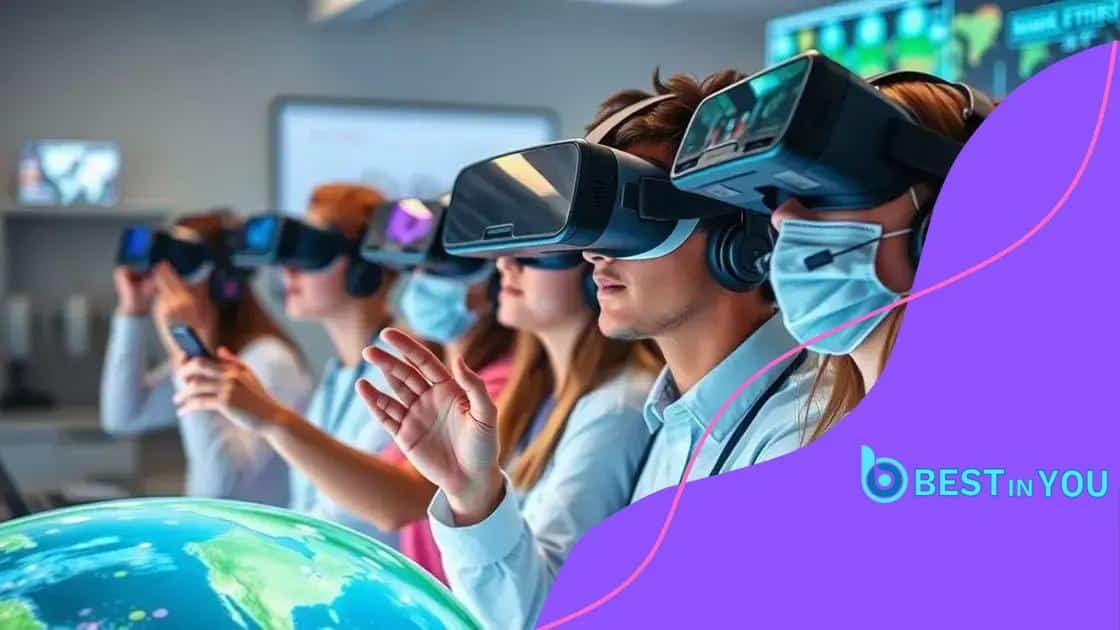
The real-world applications of VR technology extend beyond gaming and entertainment, making significant strides in various fields, especially education. In the context of STEM learning, VR has transformed traditional teaching methods into interactive experiences.
Healthcare Training
One major application of VR is in healthcare education. Medical students can practice surgeries and procedures in a realistic virtual environment without risking patient safety. This hands-on experience helps them build confidence and improve their skills.
- Students can perform simulations of complex surgeries.
- They can interact with 3D models of human anatomy.
- VR allows for repeated practice until proficiency is achieved.
By allowing students to make mistakes in a risk-free setting, VR technology enhances their learning process.
Engineering and Design
In engineering, VR has become a powerful tool for design and prototyping. Engineers can visualize their projects in a three-dimensional space, making it easier to identify potential issues before construction begins. This capability streamlines the design process and lowers costs.
- Engineers can create immersive simulations of their designs.
- Collaboration is enhanced as teams can explore projects together.
- Feedback can be integrated more efficiently during the design phase.
This not only improves communication but also fosters innovation within engineering teams.
Environmental Science Exploration
Another exciting application is in environmental science. Students can take virtual field trips to ecosystems around the globe, experiencing different environments without leaving the classroom. This exposure is invaluable for understanding complex environmental issues.
- Students learn about biodiversity in various habitats.
- They can analyze data and conduct experiments on virtual landscapes.
- Such experiences deepen their connection to environmental conservation.
Over time, these engaging activities help students develop a strong understanding of real-world challenges and the importance of sustainability.
Enhancing engagement through immersive learning
Enhancing engagement through immersive learning is a key benefit of using virtual reality in education. Students today are digital natives, growing up with technology at their fingertips. VR captures their attention and makes learning an exciting journey.
Captivating Experiences
Immersive learning environments created by VR can transport students to places they have never seen. Imagine a history lesson where students walk through ancient Rome or a biology class where they explore the human body from the inside. These captivating experiences deepens their understanding and maintains interest.
- Students remember lessons better when they can visualize content.
- Real-world scenarios make learning relevant.
- Students feel a sense of adventure, enhancing overall engagement.
This hands-on approach turns passive learning into active participation. Engagement is heightened because students are not just observing; they are experiencing.
Personalized Learning Paths
Another important aspect of VR is the ability to personalize education. Each student learns at their own pace. In a VR environment, they can revisit challenging concepts until they master them. This tailored approach caters to diverse learning styles.
- Students can explore topics that excite them.
- Adaptive learning paths can adjust based on performance.
- Feedback is instant, keeping students motivated.
This personalization fosters a deeper connection with the material. As students actively engage, the likelihood of academic success increases.
Building Collaboration and Communication
Moreover, VR fosters collaboration among students. They can work together on projects within virtual environments, enhancing their teamwork skills. Communication becomes essential as they navigate challenges together.
- Teams can solve problems in real-time.
- Students learn from each other’s perspectives.
- This collaborative environment mimics future workplace dynamics.
This social interaction adds another layer to learning, making it not only informative but also enjoyable.
The role of educators in VR integration
The role of educators in VR integration is crucial for the successful implementation of virtual reality in the classroom. Teachers serve as guides, facilitators, and innovators, helping students navigate and maximize the benefits of immersive learning experiences.
Facilitating Virtual Experiences
One of the primary responsibilities of educators is facilitating meaningful virtual experiences. This involves not only setting up the technology but also ensuring that the content aligns with educational goals. Teachers must create lesson plans that integrate VR seamlessly into their curriculum.
- They should choose relevant VR applications that enhance understanding.
- Setting clear learning objectives helps students stay focused.
- Teachers can provide context to the VR experience, making it more impactful.
By preparing effectively, educators can enhance the educational value of VR and engage students in deeper learning.
Encouraging Student Engagement
Another important role is encouraging student engagement. Educators must motivate students to participate actively in VR activities. This means creating a supportive environment where students feel comfortable exploring and learning.
- Teachers can ask open-ended questions to spark curiosity.
- They should celebrate student successes and milestones.
- Facilitating discussions after VR activities deepens understanding.
With a focus on student engagement, educators can transform VR from a novel tool into a powerful learning resource.
Continuous Learning and Adaptation
Lastly, educators must engage in continuous learning themselves. As technology evolves, teachers need to stay updated on new VR tools and best practices. Attending workshops, collaborating with peers, and seeking training opportunities can help teachers integrate VR effectively.
- Professional development should focus on immersive teaching strategies.
- Networking with other educators provides valuable insights.
- Teachers should experiment with different VR platforms to find what works best.
This dedication to growth enables educators to maximize the benefits of VR and deliver high-quality instruction.
FAQ – Frequently Asked Questions about Virtual Reality in STEM Education
What are the main benefits of using virtual reality in education?
Virtual reality enhances engagement, offers immersive learning experiences, and allows for personalized learning paths, making education more interactive and effective.
How can teachers effectively integrate VR technology into their classrooms?
Teachers can integrate VR by selecting appropriate applications, setting clear learning objectives, and facilitating guided experiences that align with the curriculum.
What challenges might educators face when implementing VR?
Challenges include technical barriers, the need for teacher training, and ensuring that all students can engage with the technology.
How does VR promote collaboration among students?
VR encourages collaboration by allowing students to work together in virtual environments, enhancing their teamwork skills and communication through shared experiences.

